On a drive to a distant put-in, I listened to an audiobook about a photographer-ethnologist visiting the same location back in 1910. His assistants were amazed at his skill in whipping together meals based around salmon he cooked over the campfire.
How efficiency could ruin sea kayaking’s soul
That evening, I was cooking dinner on perhaps the exact same beach. Well, cooking is a relative term. I was boiling water and pouring it into a bag of some unknown substance more suited for space travel.
In 2003, the Jetboil Integrated Cooking System made its debut at Outdoor Retailer. It was quickly mimicked by the nuclear-named MSR Reactor and others. With two-and-a-half-minute boil times, these acetylene-torch-as-stoves rapidly found a place in the kits of minimalists. Sea kayaking trips would never be the same. Sort of.
Long wilderness trips have been declining in length for decades
The average wilderness trip was six days in the 1980s. Now, it’s barely a weekend. There are plenty of culprits for this compression. Blame urbanization, an aging population with sore backs, helicopter parenting, lack of wilderness itself, a generation distanced from big wildlands conservation victories, Netflix and social media.
If wilderness appreciation is in poor health, then these turbo stoves are like cigarettes to lung cancer patients.
Let me explain. A basic Jetboil stove claims to boil water 30 percent faster than a standard stove. When talking in terms of percentages, it sounds like a lot. In real time, we are talking 70 seconds. Two-and-a-half minutes instead of three-and-a-half minutes to boil a liter of water. If waiting for a boil is keeping you from catching a three-knot current, you’re losing a whopping 350 feet.
Ultra-efficient stoves make sense for high elevations, when getting water to boil is difficult, and when melting snow for water. But on sea kayaking trips paddlers are at sea level and usually have nothing but time.
We wait for the tide to rise, wait out currents and wait out wind. Books, campfire stories and jokes are the real essentials. What will kayakers do with their extra 70 seconds? Probably sit around, just like as if they were waiting for the water to boil.
What’s the harm in a more efficient stove?
Maybe nothing. Stoves have been improving steadily, from Homo habilis’ cooking fires in Tanzania’s Olduvai Gorge to Alexis Soyer’s “Magic Stove,” which gave soldiers in the Crimean War something to eat other than salted pork.
In the 1980s, we lugged around tanked white gas stoves, until someone figured out how to attach the fuel bottle to the stove directly, meaning fewer spills and potential explosions. Rapid-boiler stoves are the next level of efficiency. And efficiency has its merits.
Consider this though; camping is designed to be inefficient
We give up creature comforts. We paddle at three knots when a powerboat could get us there faster. Sometimes we even hire a powerboat to drop us off just so we can paddle back to where we started.
We camp to reconnect with the primal, and nothing is more primal than how we cook food. Since the rapid-boilers really only rehydrate freeze-dried food, we’re pushed into adopting a fast-food strategy even when we have plenty time to do better.
Sea kayaking is perfect for rediscovering the increasingly rare art of good backcountry cooking
We have time and the ability to carry fresh food and keep it cool packed against the hull. Driftwood abounds for ergonomically designed camp kitchens and leave-no-trace fires. We’re even surrounded by food: seaweed and mussels grow on rocks, crabs and fish are just below the surface. Even stranger critters, like sea urchins and sea cucumbers, are tasty. No one is going to masterfully grill a rockfish on a Jetboil.
When I think of my sea kayaking trips—even those involving early morning launches or late evening arrivals in camp, my favorite part is the slow ritual of waking up and watching the sea and the birds. Starting slightly hazy and uncaffeinated, I dig food bags out of hatches, bear canisters or tree hangs to make coffee, then observe the world as it kicks in. But I’ve noticed a weakening of this ritual.
When rapid-boilers became standard gear, I shifted from brewing real coffee to packing instant espresso packets, eliminating the extra step of dumping coffee grounds out of a bag into the cone. This activity took 10 of my 70 seconds. Space wasn’t the concern—an 18-foot Explorer has plenty of room for a bag of coffee grounds. It was just the fast-and- easy mentality. We’re on a slippery slope. What next—packing NoDoz to go with our freeze-dried food?
We’re sea kayakers on vacation, not astronauts.
You know, I have a Jetboil myself. It works great, and I love light, compact gear because it’s less to haul up and down the beach. The boil-and-go approach is a gift when I’m chasing a pre-dawn current or rolling into camp hungry as the light fades. In a world driven by tides and ocean swell, a rapid-boiler adds flexibility.
More often than not, however, my ultra-efficient stove is an item I leave at home. I like to pack home-dehydrated meals and when the grub needs to be reheated, the nuclear option often creates blackened tar out of what used to be Asian noodle stir-fry. Yum.
I’ve been amazed at how many cooking styles can exist in a group of just six people. Rapid boiling is great when six people stagger out of their tents demanding coffee, but groups tend to splinter into pairs, segregated by stoves and culinary styles, ranging from boil-and-eat-out-of-a-bag to three-star Michelin aspirants with four pans and a free-range chicken.
A friend once carried a cast-iron tortilla pan in his low-volume kayak for two weeks around the Broughton Islands, saying he was going to make fresh tortillas. He never did. One fellow paced ready to hit the water while waiting for another guy to cook eggs. We could have all boiled our water for coffee on the Jetboil and eaten scrambled eggs together on the white gas stove, but individuality took over.
Obviously, the rapid-boilers haven’t ruined camp cooking any more than rudders and skegs have ruined sea kayaking by robbing us of knowing how to manage a kayak in wind.
We have met the enemy, and it’s the instant gratification and impatience dominating our non-kayaking lives. Kayaking and camping are supposed to peel back those layers, to help us live according to the rhythms of things we can’t control. My Jetboil makes this both harder and easier.



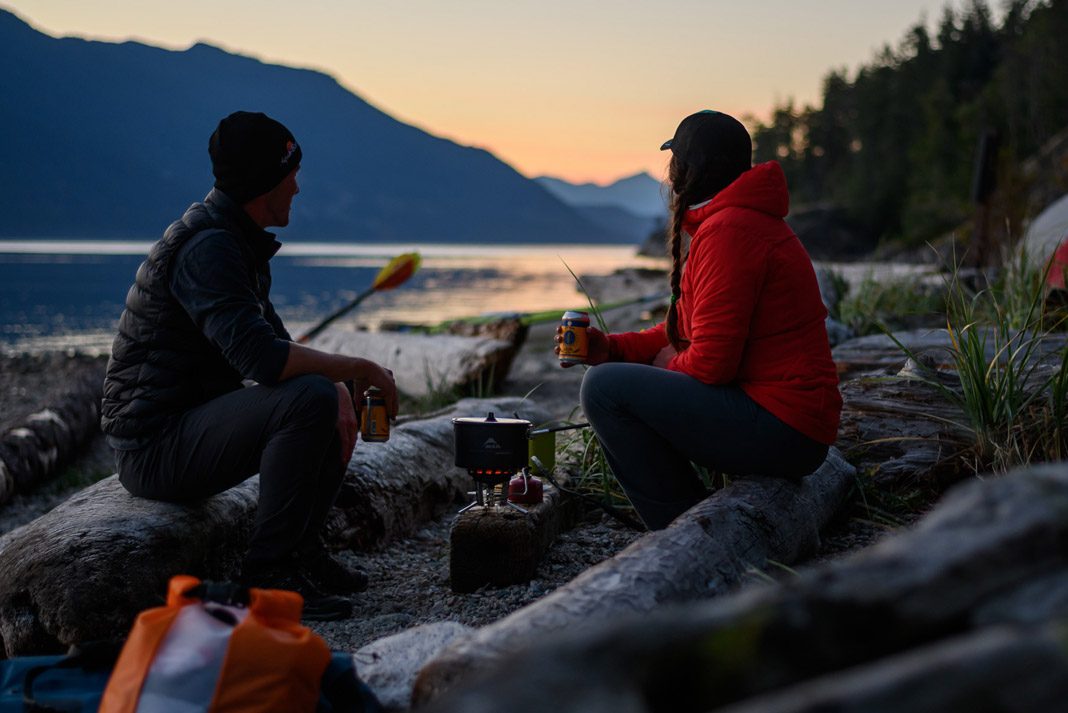
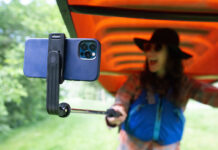
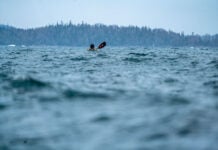
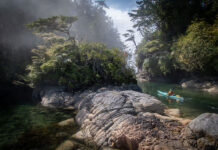
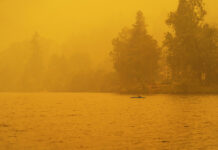
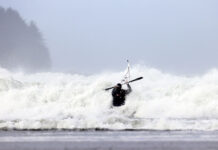

I now carry extra fuel for my stove on kayak camping trips for all those turbo charged jet boil owners how want to “cook some food” instead of nuke their dinner. Most every trip involving multiple paddlers I get requests to simmer something slowly on my low heat stove. Good article. Happy paddling.
I found this interesting, but not at all compelling. It’s like the statistical correlation between eating ice cream and drowning. Correlation, not causation. Jetboils are not ruining sea kayaking.
My partner and I spend several weeks to months at a time sea kayaking together. We likely fall in the middle of the backcountry chief scale opting to dehydrate our own efficient meals so we can carry 25+ days of food at a time into remote areas while maintaining a low bulk deck for winds/ rescues – and we don’t worry about food spoiling or throwing excess waste into the environment. Most of the time, that means boiling water. That doesn’t mean I don’t enjoy a hot cup of tea on the beach while watching seals and seabirds… or stopping to collect wild berries at the next waterfall. I just don’t see the causation.
I know folks on a budget that eat instant oatmeal PB&J every day on trips. Does that suggest that the instant gratification and impatience of their food choices affected their ability to “peel back the layers”? How are we to judge what makes an experience – a sport – pure? Doesn’t a fire on the landscape and running a stove for long periods of time have impacts too? What about technology in general here? How about texting in the woods or carrying solar panels to charge your laptop in order to update your blog? Couldn’t you say VHF radios and GPS impacted the evolution of sea kayaking? Remember the good ole days when folks used paper maps and a compass? They actually knew how to navigate, one could argue. Gortex and silnylon changed paddling. Carbon fiber changed paddling. Rudders changed boat handling. Ibuprofen changed resting. GoPro changed everything. Sponsorship changed expeditions. The “enemy” is everywhere and sea kayaking is ruined…
… or is it?
I’m a millennial in my late 20’s. I struggle with this kind of rhetoric the time. We need to remember that sea kayaking is not static or isolated. It’s been evolving since the beginning. So how to we blend together the changing world around us? How to we become in tune with the natural environment while balancing technology, morals, safety, objectives, valves, LNT, etc.? That’s ultimately up to the user to discover and for us to step back from judgement. Where you draw the line is up to you and differences in perspectives doesn’t necessarily ruin the experience.
I truly hope more people continue to discover sea kayaking. I won’t mind if they opted for a carbon paddle over a Greenland stick – or Jetboil over cast iron to boil water for their instant quinoa and freeze-dried tofu. Simply, may the adventurer continue to breath with the tides, dance in the waves, and cheers to the setting sun.
Excelent point of view, Neil! i run sea kayak trips in Brazil for 15 years and it’s clear to observe the migration from the paddling community to faster, lighter, less equipment/technic options like surfskis, outrigger canoes and SUP. Even more in tropical weathers like here. Expedition vibe will always shine people’s eyes, but the competition for your free time is increasing a lot… Long live camp fires!
Pretty pointless and dumb article here
Hanna seems to have it figured out and Michael’s critique pretty much covers it. Be Safe, Have Fun, and don’t pay too much attention to stories about kayaing in the general audience media, or pseudo experts out there.
I have half a dozen stoves, used for different trips (because I’m a gearhead and it’s an occupational hazard of mine). Whether I take my Svea 123 or my Reactor, there’s nothing substantially different in my trip except for my beautiful little Svea sounds like a jet taking off with an afterburner going. If people want to go fast and miss the experiences they pass by without notice, that’s a psychological problem unrelated to gear.
And there is a psychological problem. Being present is why I love wild places. Turn off the earbuds, put away the phone. Practice the art of doing nothing. We suck at that.
As far as the length of trips, that’s a function of a culture that celebrates being busy and large corporations giving staff limited vacation time. I own a business that requires my presence a fair amount, and saving vacation for a few one week trips a year isn’t going to do it for me: I’d rather take two days of vacation on either side of a weekend and go on lots of four day trips. Also, not everyone likes doing long trips. Don’t assume your adventure is their adventure.